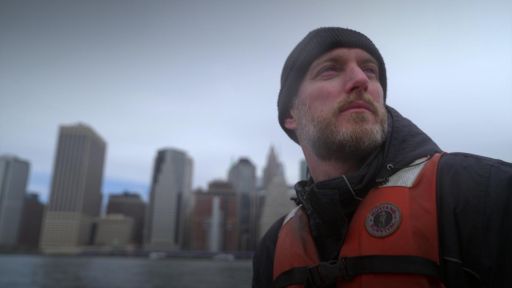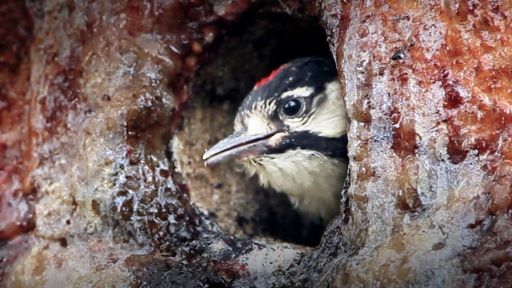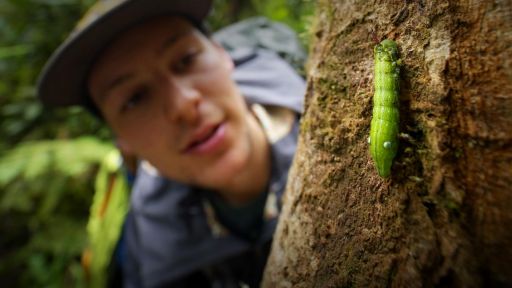TRANSCRIPT
♪ ♪ [man speaking Spanish] ♪ ♪ ♪ ♪ ♪ ♪ ♪ ♪ ♪ ♪ ♪ ♪ NARRATOR: Mexico City is home to over 20 million people-- a megacity where buildings and concrete sprawl over 500 square miles.
♪ ♪ But in a small corner of this metropolis, there's a remnant of a more natural world-- Lake Xochimilco.
And it's home to a mythical creature.
♪ ♪ [man speaking Spanish] [bird squawking] NARRATOR: Chinampas are large, man-made farming islands created by the Aztec beginning in the 14th century.
♪ ♪ They built their capital on an island in a vast lake and used a series of complex dikes, levees, and canals to keep their city from flooding.
When the Spaniards arrived, they founded Mexico City on this location.
But they ignored the Aztec's understanding of this landscape and drained the lake to prevent flooding.
All that is left of that waterworld is Lake Xochimilco.
And it's the only place in the wild to find a creature that was revered by the Aztec: a salamander known as the axolotl, named after one of the most powerful Aztec gods.
But how many still survive in these urban waters?
LUIS ZAMBRANO: Not too many.
The problem was that nobody cared.
NARRATOR: Dr. Luis Zambrano has been leading the effort to save wild axolotls for almost 20 years.
But it wasn't quite love at first sight.
LUIS: As I always said, my love with axolotls is a second date love, it was not first date love.
♪ ♪ Normally the first date is with people basically that you are attracted to.
Would be something like a mammal-- a whale, a wolf or a bear or something like that that you like a lot.
And the axolotls are the complete opposite.
They are really, really slimy, small, dark, but they are really interesting in many ways.
NARRATOR: Luis has seen firsthand how this remarkable creature has charmed its way into many hearts.
LUIS: Suddenly, in the last 10, 15 years, the animal became really, really popular nationally and internationally.
You started to see people in love of axolotls in Germany, in Japan, in Korea, in the US, they love the axolotls as pets.
All the biological characteristics, all the cultural characteristics helped a lot of the popularity.
NARRATOR: Some of the adulation may have to do with its extraordinary abilities.
LUIS: The axolotl can regrow tissues.
If it loses the limb or it loses the tail or it loses the gills, or even if it loses the eye or the brain, he or she can regenerate the tissues and be as good as new.
NARRATOR: As the axolotl has gained more fans, the captive-bred population has risen to about a million.
But those condemned to a shrinking and polluted natural habitat are dying out.
♪ ♪ LUIS: The first time that there was a census for the axolotls was in 1998.
NARRATOR: At the time the team counted 6,000 axolotls per square kilometer.
♪ ♪ LUIS: And the last one, we did it in 2014-15, was 36.
So, in almost 20 years, the axolotl's population reduced from 6,000 to 36 per square kilometer.
The biggest threats for the axolotls are water quality, which is changing all the time, and exotic species, such as carp and tilapia.
NARRATOR: These fish were added to Mexico City's waterways in the seventies as an additional food source.
Unfortunately, they soon began to prey on axolotl eggs and young.
LUIS: So to reduce these threats, we started to work with chinamperos that have the chinampas.
♪ ♪ NARRATOR: Chinamperos are the farmers who maintain these man-made islands.
Carlos has spent the last decade cultivating this partnership, working to apply sustainable farming practices that can restore the axolotl's delicate ecosystem.
[speaking Spanish] ♪ ♪ NARRATOR: These refuges are part of a farming technique that cleans the water in the surrounding canals for crop irrigation instead of using pesticides.
♪ ♪ NARRATOR: A new generation of farmers is joining in the campaign to restore the axolotl's home.
♪ ♪ [woman speaking Spanish] NARRATOR: Claudia Medina Castillo was a young child when her grandparents sold off their land because her family had other plans for her and her siblings.
NARRATOR: So Claudia decided to put her biology degree to work in a chinampa.
♪ ♪ [Carlos speaking] [Claudia speaking] NARRATOR: A decade of hard work rebuilding biodiversity in these refuges is paying off and creating safe space for the axolotls in the chinampas.
[rooster crows] [laughing] NARRATOR: Clean water and plenty of food for an axolotl-- these are the signs the team was hoping for.
♪ ♪ NARRATOR: The axolotl is not the only salamander in Mexico facing extinction in the wild.
About 200 miles west, the critically endangered achoque is disappearing from its only native habitat: Lake Pátzcuaro.
Scientists here are scrambling to understand this less-studied species, and that means gathering a lot of real-world data.
LUIS ESCALERA VÁZQUEZ: We're gonna take some samples from the mud to know which macroinvertebrates we have for potential preys for achoques, in terms of insects or worms, stuff like that.
And we are monitoring populations of achoques in order to know if the abundance is related to seasonal changes or to anthropogenic or global changes.
♪ ♪ NARRATOR: Both the achoque and axolotl are close cousins of the tiger salamander, which starts its life underwater before maturing and moving onto land.
♪ ♪ But the isolated lakes in central Mexico's volcanic landscape spurred a remarkable adaptation.
Finding fewer predators and plenty of food in the lakes, these two species evolved over the past million years to spend their entire lives in water-- becoming adults but keeping their juvenile features.
But like the axolotl's urban wetland, the achoque's home faces man-made threats of its own: pollution and climate change.
So these scientists have partnered with local fishermen to help the achoque rebound.
[Luis speaking] LUIS: Five years?
Something like that.
NARRATOR: Sergio Esquivel knows these waters better than just about anyone.
[Sergio speaking] ♪ ♪ NARRATOR: The stakes are personal.
Improving the ecosystem for achoques is also vital for the fishing community.
Over the years, wastewater and farm chemicals drained into the lake, creating toxic conditions and depleting stocks also hit by overfishing.
[Sergio speaking] NARRATOR: Achoques, like all amphibians, have permeable skin that makes them sensitive to pollutants.
Because of this, they are considered a bioindicator species.
So over the years, researchers have worked with several towns that surround the lake to curtail domestic and agricultural pollution.
NARRATOR: Today Luis and his team are focusing on finding an achoque.
LUIS: At the beginning of the project we tried different trapping techniques.
This was the most effective and harmless technique for achoque.
LUIS: Whoa.
[laughing] [speaking Spanish] SERGIO: Ay caramba.
[laughter] NARRATOR: Finding this animal is a big deal.
It's estimated that there may be fewer than 100 achoques left in this entire lake.
They'll size up this adult and then set it free.
LUIS: Measure how tall he is, or she is.
Male, female.
What it's eating.
We process the data, scientifically speaking, in order to recognize the useful thing of this information.
NARRATOR: Lake Pátzcuaro has 50 square miles of surface area, and the team constantly monitors water quality across all of it.
It helps them understand how conditions impact the achoques today, and when the water might be clean enough to reintroduce captive-bred populations to the lake.
[motor whirring] It's an ambitious goal.
But this team has an important advantage: They've done this before.
♪ ♪ [man speaking Spanish] NARRATOR: Omar Domínguez is a biologist at the University of Michoacán.
He leads the achoque conservation team and is modeling their approach on previous success with another species: the tequila fish.
[Omar speaking] NARRATOR: Like the axolotl, however, tequila fish were thriving in captivity.
NARRATOR: But reintroduction isn't as simple as dumping fish into a river.
First, you have to understand why they went extinct there in the first place.
♪ ♪ [Omar speaking] NARRATOR: The team figured out that the likely culprits were familiar foes-- pollution and invasive species-- and soon targeted a release location.
Then they introduced fish they had bred in captivity.
NARRATOR: The prep work is similar: evaluate the wild population and the state of the ecosystem.
But there are real differences between raising tequila fish and achoques.
[conversing in Spanish] [man speaking Spanish] ♪ ♪ NARRATOR: Understanding how to replicate a healthy, natural environment and successfully raise achoques requires painstaking experimentation.
The scientists got a head start by collaborating with an unlikely ally.
♪ ♪ Omar and his team first came to the Basílica de Nuestra Señora de la Salud about 20 years ago... Not for divine intervention.
This church is home to a group of Dominican nuns who are expert achoque breeders.
♪ ♪ NARRATOR: Sister Maria del Carmen Pérez has worked with achoques ever since joining this convent.
♪ ♪ ♪ ♪ NARRATOR: The notion that achoques can improve human health goes back about a millennium.
The Purépecha people who settled in the Michoacán region in the 11th century saw the achoque as an important medicinal source.
Then, about a hundred years ago, the convent started using the achoque as the key ingredient in a cough syrup.
Now their elixir is such a staple that street vendors hawk their own varieties.
♪ ♪ NARRATOR: The syrup became an important part of the convent's work.
So when wild achoque numbers crashed in the 1980s, the sisters came up with a solution-- breeding their own colony.
NARRATOR: And helped they have.
The nuns approached the crisis with scientific rigor, microchipping the animals and developing breeding protocols.
In just a few decades, they have created a genetically diverse population that could one day help repopulate the lake.
♪ ♪ NARRATOR: It's the scientists' hope that the nuns' passion for the achoque will be adopted by the local community as well.
And that's where Dr. Federico Hernández Valencia comes in.
NARRATOR: The scientists worry that their efforts to restore the wild achoque population could be in vain unless the community becomes invested in the creature's survival.
[bird chirping] To raise awareness, a local zoo is putting on an exhibit called "The Wonderful World of Achoque."
GIRL: Sí.
NARRATOR: The team also enlists the help of local artists to broaden the achoque's appeal.
♪ ♪ ♪ ♪ [laughter] ♪ ♪ NARRATOR: For Federico, the part he loves most about his outreach work is kindling a sense of wonder in the next generation.
♪ ♪ [girl laughs] ♪ ♪ NARRATOR: Back in Mexico City, community support for the axolotl is already deeply rooted.
Its imagery is everywhere.
And in Lake Xochimilco, Luis Zambrano's team is back at the newly cleaned canal by Claudia's chinampa for a major step in the conservation process-- a controlled re-introduction.
NARRATOR: Horacio Mena and his team will check on the axolotl regularly.
If this pioneer does well, they'll release more axolotls over the coming months.
[woman speaking Spanish] NARRATOR: Rebalancing this ecosystem would be a victory for conservationists everywhere.
NARRATOR: Rescuing these embattled amphibians has deeper implications.
It's touching the hearts of many, linking communities, and rejuvenating polluted habitats for plants, wildlife, and people alike.
Restoring an ancient balance in a much changed world.
♪ ♪







